TL;DR
Austin homeowners living in HOA communities must follow both city fence regulations and HOA-specific design restrictions. Your HOA typically controls materials, color, height, and placement. The City of Austin enforces safety and permit requirements. Always secure HOA approval before construction to avoid fines or removal orders.
Why HOA Rules Matter for Your Fence in Austin
 If you live in a homeowners’ association (HOA) community in Austin, you can’t simply build any fence you like. HOAs enforce aesthetic uniformity, neighborhood value, and safety standards that often go beyond city requirements.
If you live in a homeowners’ association (HOA) community in Austin, you can’t simply build any fence you like. HOAs enforce aesthetic uniformity, neighborhood value, and safety standards that often go beyond city requirements.
Unlike general city codes, HOA rules cover details such as:
- Fence color and finish
- Approved materials (e.g., cedar, iron, composite)
- Maximum height and style
- Placement within property boundaries
Most HOAs require written approval from their Architectural Control Committee (ACC) before any construction begins. Skipping this step could result in costly removal orders or fines.
Understanding City of Austin Fence Regulations
Even if your HOA approves your design, you must still comply with the City of Austin fence codes. These regulations ensure public safety and proper land use.
According to Austin Fence Laws: What Homeowners Need to Know Before Installation:
- Residential fences generally cannot exceed 6 feet in height along property lines.
- Corner lots must maintain clear visibility at intersections (no tall fences blocking views).
- “Safe Fencing” laws prohibit spikes or sharp features above the top rail.
- A permit may be required for fences above certain heights or for properties near floodplains.
For a complete breakdown, visit the Fence Installation page, where we cover design and permitting best practices.
Common HOA Fence Restrictions in Austin Communities
Each HOA in Austin has its own Covenants, Conditions & Restrictions (CC&Rs). While the details differ, most share similar requirements:
1. Material and Color Rules
- Cedar, wrought iron, or composite are usually allowed.
- Chain-link or corrugated-metal fences are often prohibited.
- HOA-approved stains or paints maintain neighborhood consistency.
2. Height and Design
- Typical height limits range from 4 to 6 feet.
- Front-yard fences are often shorter (about 4 feet) to preserve curb appeal.
- Decorative tops or lattice designs may be regulated or restricted.
3. Location and Setbacks
- Fences must stay inside property lines and away from easements.
- Some HOAs ban perimeter fences adjacent to public walkways or parks.
4. Approval Process
Most HOAs require homeowners to submit:
- A site plan or drawing
- Material and color samples
- Contractor details and timeline
The ACC committee typically reviews applications within 14–30 days.
Steps to Get HOA Fence Approval in Austin
To avoid delays or penalties, follow this step-by-step guide before you start any fence project:
- Review Your HOA’s CC&Rs – Look for specific guidelines under “Fencing” or “Architectural Standards.”
- Consult with a Licensed Contractor – Professionals familiar with Austin HOAs, like Austin Fence Contractor, can help you interpret unclear clauses.
- Submit an Application – Include plans, materials, colors, and property sketches.
- Wait for Written Approval – Never begin construction until approval is confirmed.
- Apply for a City Permit (if required) – For fences exceeding 6 feet or near easements, obtain approval through the City of Austin’s Development Services.
- Schedule an Inspection (if applicable) – Some HOAs or city departments may require a final inspection for compliance.
To streamline your project, check our guide on How to Get a Fence Permit in Austin.
What Happens If You Violate HOA or City Rules
Ignoring HOA or city regulations can lead to:
- Fines and daily penalties
- Forced fence removal at the homeowner’s expense
- Legal action from the HOA for covenant violations
- Delays in home sale or refinancing (non-compliance flags in HOA reports)
In severe cases, your HOA can place a lien on your property until violations are corrected.
Combining City & HOA Compliance for a Smooth Fence Project
The best strategy is to design your project around both sets of rules.
Here’s how to stay compliant and stress-free:
- Begin with the City of Austin code review for height and safety limits.
- Overlay your HOA’s aesthetic rules (materials, colors, visibility).
- Use professional installers who are familiar with HOA submission processes.
- Keep documentation and permits handy for future inspections.
By blending HOA and city requirements, you’ll ensure your new fence enhances property value, maintains harmony, and stands legally compliant.
Why Choose Austin Fence Contractor for HOA-Compliant Fencing
 At Austin Fence Contractor, we’ve helped countless homeowners navigate the complex mix of HOA approvals and city permits.
At Austin Fence Contractor, we’ve helped countless homeowners navigate the complex mix of HOA approvals and city permits.
Our expertise ensures:
- Proper documentation and submission to HOA boards
- Fence designs that meet Austin’s code and your HOA’s standards.
- Efficient project timelines and professional craftsmanship
- Transparent pricing and long-term warranty support
Whether you need a repair, a replacement, or a new installation, we can help you stay compliant while improving your property’s curb appeal.
Explore our services:
Frequently Asked Questions (FAQ)
1. Can my HOA stop me from installing a fence?
Yes. HOAs in Austin can deny fence applications that don’t align with design standards or violate neighborhood guidelines.
2. How tall can my fence be in Austin?
City regulations limit fences to 6 feet in residential zones, but your HOA may impose stricter limits for visibility or uniformity.
3. Do I need both HOA and city approval?
Yes — HOAs handle aesthetics, while the city ensures safety and zoning compliance. You must satisfy both.
4. How long does HOA approval take?
Most committees review applications within two to four weeks, depending on meeting schedules.
5. What if I already built my fence without HOA approval?
You may receive a violation notice. The HOA can require modifications or removals, or impose fines until compliance is achieved.
Building a fence in an HOA-regulated Austin neighborhood requires careful planning, clear documentation, and an understanding of both city codes and HOA restrictions.
Partnering with an experienced local contractor like Austin Fence Contractor ensures your project meets all standards — legal, structural, and aesthetic.


Recent Comments